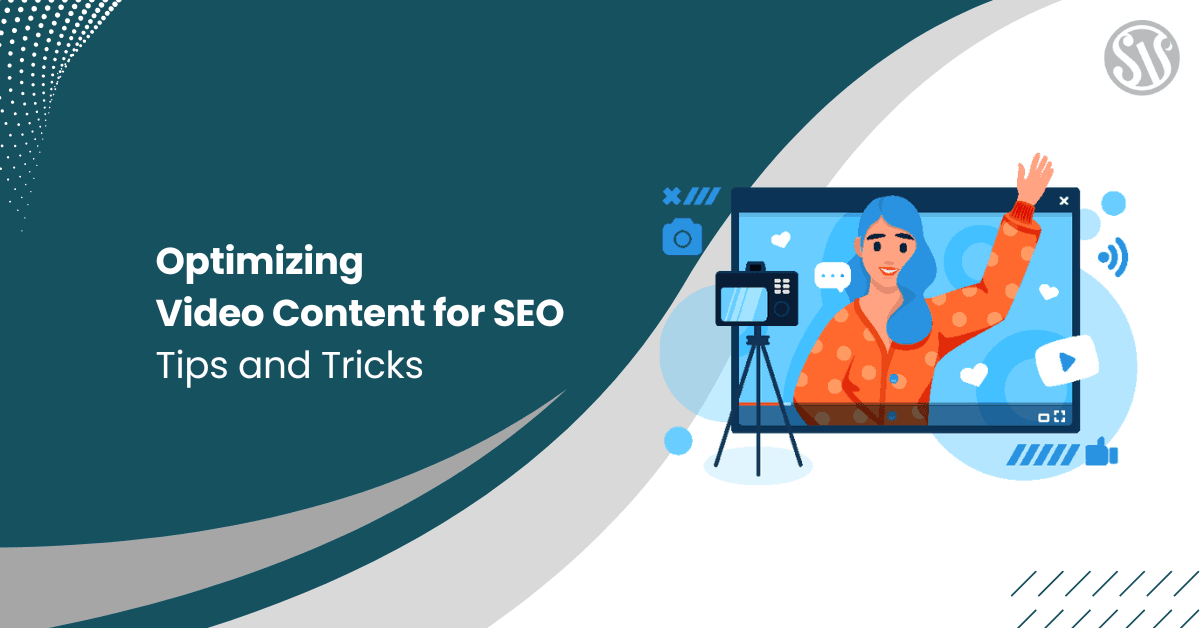Optimizing Video Content for SEO: Tips and Tricks
Video content has emerged as one of the most powerful tools for engaging audiences and driving traffic. Whether you’re a seasoned marketer or just beginning your journey in digital marketing, understanding how to optimize video content for SEO can set you apart from the competition.
This guide provides actionable tips and tricks to ensure your video content reaches and resonates with your target audience, improving visibility and engagement.
Why Video SEO Matters
Videos are rapidly becoming the preferred medium for content consumption. Search engines like Google continually refine their algorithms to prioritize rich, engaging content. When your video is optimized for SEO, it can rank higher in SERPs, drive more organic traffic, and ultimately increase conversions.
- Enhanced Engagement and Retention: Videos keep viewers engaged longer than text-based content. A well-optimized video can reduce bounce rates and improve user dwell time, two key factors that search engines consider when ranking pages.
- Diversified Content Strategy: You diversify your content offerings by integrating video content into your SEO strategy. This diversification can help capture different audience segments, including those who prefer visual learning or are on mobile devices.
Understanding Video SEO
Video SEO involves several components that collectively improve the discoverability and ranking of your video content. Unlike traditional text-based SEO, video SEO requires a multi-faceted approach that includes both on-page and off-page elements and technical enhancements.
Key Components of Video SEO
- Video Metadata: This includes your video’s title, description, and tags. Properly optimized metadata helps search engines understand the context and content of your video.
- Transcriptions and Captions: Adding transcriptions or closed captions can improve accessibility and allow search engines to index the spoken content within your videos.
- Video Thumbnails: An engaging and relevant thumbnail can significantly improve CTR from search results and social media shares.
- Video Sitemaps: Including your video content in a sitemap ensures that search engines can easily crawl and index your videos.
- User Engagement Metrics: Metrics such as watch time, likes, comments, and shares provide valuable insights into how viewers interact with your content, influencing search engine rankings.
Crafting SEO-Friendly Video Content
Creating content that ranks well involves planning, quality production, and smart optimization tactics. Below are several strategies to ensure your video content is primed for SEO success.
1. Conduct Thorough Keyword Research
Just like text-based content, videos benefit immensely from keyword research. Identify long-tail keywords and phrases your target audience will likely search for. Use tools like Google Keyword Planner, Ahrefs, or SEMrush to pinpoint keywords with a good balance of search volume and low competition.
- Title Optimization: Incorporate your primary keyword naturally into the video title. A compelling title that includes your keyword will help your video stand out in search results.
- Description and Tags: Write a detailed description that outlines the key points of your video and includes relevant keywords. Don’t forget to add a few targeted tags to further assist search engines in categorizing your content.
2. Create High-Quality, Engaging Videos
Content quality is king in the world of SEO. Invest in good production equipment, plan your script meticulously, and ensure the final product is engaging and valuable to your viewers.
- Storytelling: A narrative that hooks viewers from the start and delivers a clear message is essential. Good storytelling boosts viewer engagement and encourages sharing and repeat visits.
- Visual and Audio Quality: Clear visuals and crisp audio are critical for viewer retention. Poor quality can lead to high bounce rates, negatively impacting your SEO efforts.
- Length and Structure: There’s no one-size-fits-all rule for video length. However, ensure that your content is long enough to be comprehensive but concise enough to maintain attention. Break longer videos into sections or chapters to facilitate easier navigation.
3. Optimize Video Metadata
Metadata provides search engines with crucial information about your video. Ensure that every element is optimized for maximum impact.
- Title: Keep it clear, descriptive, and engaging. Use your primary keyword naturally.
- Description: Write an in-depth summary of your video. Consider including a call-to-action (CTA) and links to related content on your website.
- Tags: Use a mix of broad and specific tags that accurately describe your video’s content.
4. Utilize Transcriptions and Closed Captions
Transcriptions make your video content accessible to a broader audience, including those with hearing impairments and provide additional text for search engines to crawl. This can significantly improve your video’s ranking in SERPs.
- Manual vs. Automated Transcriptions: While automated transcriptions are convenient, consider manually editing them for accuracy. A precise transcription reflects your brand well and ensures better SEO results.
- Enhanced Accessibility: Beyond SEO, providing captions and transcripts demonstrates your commitment to accessibility, potentially increasing viewer engagement and loyalty.
5. Design Eye-Catching Thumbnails
Your video thumbnail is the first impression a potential viewer gets. A well-designed thumbnail can dramatically improve your CTR.
- Consistency: Develop a consistent style that aligns with your brand identity. Consistent visuals can help in building brand recognition.
- Quality: Use high-resolution images and ensure the thumbnail accurately represents the video’s content. A misleading thumbnail might result in high bounce rates.
Technical Tips for Video SEO
While content is vital, the technical setup of your video also plays a critical role in optimization. Here are some technical aspects to consider:
Video Hosting: Choosing the Right Platform
One of your first decisions is where to host your videos. Each platform has its benefits and drawbacks.
- YouTube: As the second largest search engine globally, YouTube offers extensive reach and built-in SEO benefits. Optimize your YouTube channel using descriptive titles, detailed descriptions, and relevant tags. However, remember that hosting on YouTube means you’re subject to its algorithm and potential distractions from recommended videos.
- Self-Hosting: Self-hosting gives you complete control over your content and the viewer experience. You can optimize the player and customize the user interface to match your website’s design. On the downside, self-hosting requires more bandwidth and might not offer the same level of discovery as platforms like YouTube.
- Third-Party Platforms: Platforms such as Vimeo provide a balance between self-hosting and YouTube. They offer a professional look and feel, often appealing to niche audiences and industries.
Implementing Video Sitemaps
A video sitemap is a specialized XML sitemap that helps search engines locate and index your video content more efficiently. Including details such as video title, description, duration, and thumbnail URL can significantly boost your video’s visibility in search results.
- Google’s Guidelines: Follow Google’s best practices for creating video sitemaps. Ensure that each video entry includes all the necessary details for optimal indexing.
- Regular Updates: Keep your video sitemap updated whenever you add new video content. This ensures search engines are aware of your latest uploads and improvements.
Ensuring Fast Load Times
Website speed is a crucial ranking factor. Videos, especially high-definition ones, can slow down your page load times if not optimized correctly.
- Compression: Compress video files to reduce load times without sacrificing quality.
- CDNs: Use a CDN to serve your videos faster by distributing the content across multiple servers.
- Lazy Loading: Implement lazy loading for videos so that they only load when a user scrolls to the part of the page where the video is embedded.
Leveraging Off-Page SEO for Video Content
While on-page optimizations are essential, off-page SEO strategies can enhance your video’s visibility further.
Social Media Promotion
Social platforms are excellent channels for distributing video content. Share your videos on Facebook, X(Twitter), LinkedIn, and Instagram to reach broader audiences. Social signals like, shares, and comments can indirectly impact your SEO by increasing traffic and engagement.
- Engagement Tactics: Create teasers, behind-the-scenes content, or short clips to drive interest and prompt viewers to watch the full video on your site.
- Cross-Promotion: Embed videos in blog posts and share them across your social media channels to maximize reach.
Influencer and Partnership Outreach
Collaborate with influencers or industry leaders to expand your video’s reach. Partnerships can lead to co-branded videos or guest appearances, providing mutual benefits regarding audience growth and authority.
- Guest Videos: Invite influencers to contribute to your video content or feature your expertise on their platforms. This not only broadens your reach but also adds credibility to your brand.
- Backlink Opportunities: Quality backlinks from reputable sites can boost your video’s SEO. Contact industry blogs, websites, or online communities that might find your content valuable and request a link.
Measuring the Success of Your Video SEO Strategy
Tracking and analyzing performance is critical for any SEO strategy. Use various metrics and tools to gauge the effectiveness of your video content.
Key Metrics to Monitor
- View Count and Watch Time: High view counts and longer watch times are indicators of engaging content.
- CTR: Monitor the number of users who click on your video after seeing it in search results or social media.
- Engagement: Track likes, shares, comments, and other interaction metrics. Higher engagement often correlates with better rankings.
- Bounce Rate: A lower bounce rate suggests visitors find your video content relevant and engaging.
Analytics Tools
Several tools can help you measure video performance:
- Google Analytics: Use Google Analytics to monitor traffic, user behavior, and conversion metrics for pages hosting your videos.
- YouTube Analytics: If you’re using YouTube, leverage its built-in analytics to understand viewer demographics, engagement patterns, and retention rates.
- Third-Party SEO Tools: Platforms like SEMrush, Ahrefs, or Moz can provide insights into how your videos perform in search rankings and suggest improvements.
Conclusion
Optimizing video content for SEO is a dynamic, multi-layered process requiring creativity and technical know-how. From keyword research and metadata optimization to ensuring fast load times and leveraging off-page tactics, every detail boosts your video’s visibility and engagement.
Implementing the tips and tricks outlined in this guide can enhance your video content’s search engine performance and attract a larger, more engaged audience. So, start implementing these techniques, monitor your progress, and be prepared to adapt as search engine algorithms evolve.
The world of video content is rich with opportunities, and with the right strategy, you can transform casual viewers into loyal customers.







